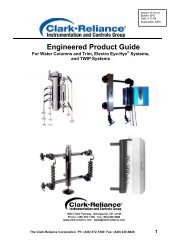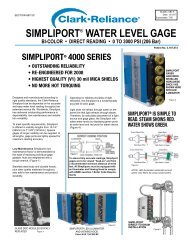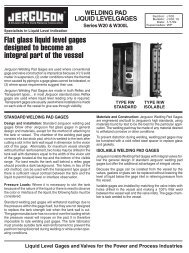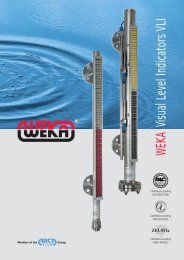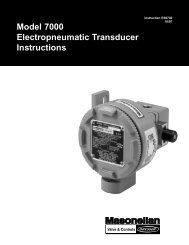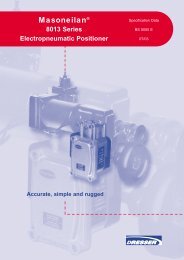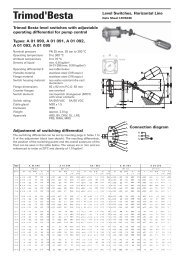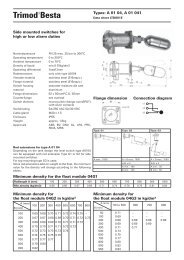1511 Series - Maintenance Manual
1511 Series - Maintenance Manual
1511 Series - Maintenance Manual
- No tags were found...
You also want an ePaper? Increase the reach of your titles
YUMPU automatically turns print PDFs into web optimized ePapers that Google loves.
X. Hydrostatic Testing & GaggingA. General InformationDuring any hydrostatic test all safety valves on the unit must be gagged. Thisgagging procedure prevents the possibility of damage to the safety valve internalsin the event that the test pressure exceeds the safety valve set pressure.When hydrostatic pressure will exceed the set pressure of the safety valve, it isrecommended the valve be replaced with a blind flange during hydrostatic testing.Probably the most common source of safety valve trouble is overgagging. Duringhydrostatic testing, and during safety valve setting, gags should be applied onlyhand tight. During setting, overgagging could cause damage to the seating surfaceand result in leakage. In applying gags, remember that the valve spring will hold thevalve closed against its set pressure. The additional gag load applied should be onlyenough to insure that the valves do not lift at the expected over-pressure.Gags should never be applied when the boiler is cold. The spindle of the safety valveexpands considerably with the temperature increase as pressure is raised. If it is notfree to expand with this temperature change, the spindle may be damaged.Boiler pressure should be increased to 80% of the pressure of the low set valvebefore applying the gags.Hand tighten the gags of drum and superheater valves with only a light force.B. Application of Test Gags (All Pressures)1. Refer to Figures 1 & 2 on Section V. Remove lever pin and lever. Then loosencap screw and remove cap.2. Center the test gag screw in the exposed end of the spindle and hook the legsof gag under the sides of the yoke as shown in Figure 4.Do not apply the gag load until the boiler hydrostatic pressure is equalto 80% of the pressure to which the low set valve is adjusted.3. Apply the gag load by turning the gag screw clockwise. If the gag on any valvehas not been tightened sufficiently, the valve will leak.If this occurs, the hydrostatic test pressure should be reduced until thevalve becomes tight and then the gag should be tightened still further.This procedure must be followed exactly since it is very difficult to stop the leakby additional gagging once it has started. Any attempt to pinch off the leakagethrough the valve without first lowering the hydrostatic pressure may result indamage to the valve seats.4. After the hydrostatic test is completed, the gags should be removed when thehydrostatic pressure has been reduced to 85% to 90% of the low set valve.Under no circumstances should the gags be left on valves with nohydrostatic pressure on the system.Gag safety valve duringring adjustments to avoidpossible severe personalinjury or death.Figure 412 | Dresser Consolidated ®




